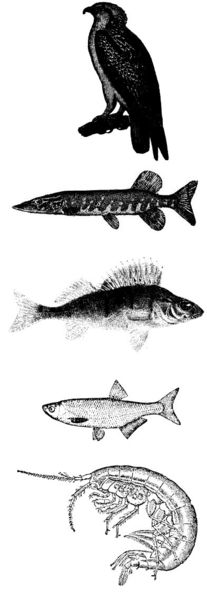The title of the consumer at the highest level of a food chain is an apex predator, also referred to as an alpha predator, top predator, or top-level predator.
A food chain simply shows how living things get food, so there are many different types of food chains. Most food chains have producers, consumers and decomposers. The highest level “consumer” is often referred to as the apex predator. An apex predator is a consumer at the top of the food chain which is not preyed upon by any other predator. That said, most food chains end with what is called a decomposer. Also, in most ecosystems, organisms are usually part of intersecting food chains called food webs.
Producers, consumers and decomposers
The vast majority of primary producers produce food by photosynthesis (eg: Plants).
Consumers must eat other organisms for energy. Consumers have various methods of consumption. Animals, such as wolves, consume as predators, while herbivorous animals obtain nutrition by browsing and grazing on bushes, trees, and other plant like material. Consumers are categorized into three groups: primary consumers, secondary consumers, and the tertiary consumers.
Finally, decomposers are organisms which break down dead or decaying organisms.
Image credit: See page for author [Public domain or Public domain], via Wikimedia Commons
Related FAQs
What is the difference between a food chain and a food web?
A food chain is typically a list of living organisms which begin with a producer and end with an apex predator (more on food chains). A food web is a natural interconnection of food chains of what can consume what in an ecological community. You can read more on food webs here.
What is the difference between a predator and an apex predator?
In a food chain there are many consumers. Some consumers, such as herbivores, eat plants. Most animals are herbivores. However, some animals are classified as omnivores or carnivores. Omnivores eat both plants and animals. Carnivorous animals primarily eat or exclusively eat meat. A predator hunts and kills other animals for food. There can be many predators in a food chain. An apex predator, or top predator, is at the top of a food chain as they have no natural enemies. For more information visit this page on trophic levels.
What are some examples of Apex Predators?
These apex predators are the highest level consumer on their food chains. Of course, this can vary from food chain to food chain: human, leopard, lion, bobcat, cougar, osprey, and bull shark. For a more comprehensive list of apex predators please see wikipedia’s list of apex predators.
What is a primary producer?
A primary producer is an organism which makes its own food from a primary energy source. In most cases, the sun is the primary energy source, and a primary producer creates their food via photosynthesis. Examples of primary producers are: grass, algae, and phytoplankton.
Why isn’t a decomposer at the top of a food chain?
Decomposers are organisms that break down dead organisms. This is known as decomposition. Decomposers are heteroptrophs, which get their energy and nutrients from organic material which are used for growth. Consumers and decomposers are both heterotrophs. However, unlike an apex predator, decomposers do not “eat”. A food chain can have producers, consumers, and decomposers; in that case, the consumer at the highest level of a food chain is still the apex predator, as consumers and decomposers are two different things. Also see: detritivore.
- Google “Pure Spam” Penalty Deindexes Sites March 6 2024 - March 12, 2024
- What Happened to ChicagoNow.com? - August 30, 2022
- The December 2021 Google Local Pack Algorithm Update - December 17, 2021





Leave a Reply